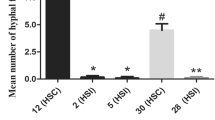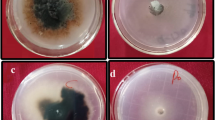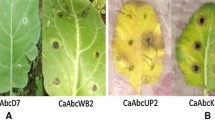Abstract
Bipolaris sorokiniana is a phytopathogenic fungus that causes diseases of cereal crops, such as leaf-spot disease, common root rot, and black point of grain. Because of its great morphological, physiological, and genetic variability, this fungus is difficult to control. The aim of this investigation was to study the variability of isolates of B. sorokiniana by means of vegetative incompatibility. Thirty-five isolates of B. sorokiniana from different geographical regions in Brazil and other countries were used. The vegetative incompatibility between the isolates and the influences of different culture media on these reactions were evaluated. The total protein profile of the isolates was analyzed when the isolates were cultured separately, and in cultures of compatibility and incompatibility reactions. Eighteen of 31 confrontations showed vegetative incompatibility. The results obtained with different culture media for the vegetative compatibility/incompatibility genotypes suggested that the type of substratum influences these reactions. No differences in protein profiles among the isolates were observed. This result suggests that there is no induction of expression of different proteins in vegetative incompatibility reactions.


Similar content being viewed by others
References
Aimi T, Yotsutani Y, Morinaga T (2002) Cytological analysis of anastomoses and vegetative incompatibility reactions in Helicobasidium monpa. Curr Microbiol 44:148–152
Bellahcene M, Fortas Z, Fernandez D, Nicole M (2005) Vegetative compatibility of Verticillium dahlia isolated from olive trees (Olea europea L.) in Algeria. Afr J Biotechnol 4:963–967
Cherepennikova-Anikina MI, Savenkova LV, Dolgova AV, Shaw DS, Dyakov YT (2002) Vegetative incompatibility of Phytophthora infestans. J Russ Phytopathol Soc 3:19–32
Christensen JJ (1925) Physiologic specialization and mutation in Helminthosporium sativum. Phytopathology 15:785–795
Day PR (1974) Genetics of host parasite interaction. W. H. Freeman, San Francisco
Duczek LJ (1984) Comparision of common root rot reaction of barley lines and cultivars in northwestern Alberta and central Saskatchewan. Can J Plant Pathol 6:81–89
Giovannetti M, Sbrana C, Strani P, Agnolucci M, Rinaudo V, Avio L (2003) Genetic diversity of isolates of Glomus mosseae from different geographic areas detected by vegetative compatibility testing and biochemical and molecular analysis. Appl Environ Microbiol 69:616–624
Glass NL, Jacobson DJ, Shiu PKT (2000) The genetics of hyphal fusion and vegetative incompatibility in filamentous ascomycete fungi. Annu Rev Genet 34:165–186
Griffin DH (1994) Fungal physiology, 2nd edn. Wiley, New York
Guseva NN, Levitin MM, Mikhailova LA (1979) Genetic mechanisms of variability of phytopathogenic fungi. Acta Phytopathol Acad Sci Hung 14:441–447
Mahmoud YAG, Gaafar RM, Mubarak HM (2007) Genetic diversity among Nile Delta isolates of Rhizoctonia solani Kuhn based on pathogenicity, compatibility, isozyme analysis and total protein pattern. Turk J Bot 31:19–29
Marek SM, Wu J, Glass NL, Gilchrist DG, Bostock RM (2003) Nuclear DNA degradation during heterokarion incompatibility in Neurospora crassa. Fungal Genet Biol 40:126–137
Muller MVG, Germani JC, Van Der Sand ST (2005) The use of RAPD to characterize Bipolaris sorokiniana isolates. Genet Mol Res 4:642–652
Nascimento EJM, Van Der Sand ST (2008) Restriction analysis of the amplified ribosomal DNA spacers ITS1 and ITS2 of Bipolaris sorokiniana isolates. World J Microbiol Biotechnol 24:647–652
Oliveira AMR, Matsumura ATS, Prestes AM, Matos GS, Van Der Sand ST (1998) Variabilidade patogênica e morfológica em isolados de Bipolaris sorokiniana. Fitopatol Bras 23:349–353
Powell JF, Vargas JM (2001) Vegetative compatibility and seasonal variation among isolates of Sclerotinia homoeocarpa. Plant Dis 85:377–381
Roca MMG, Machado JDC, Vieira MGC, Davide LC, Rocha ML (2004) Compatibilidade sexual e vegetativa do complexo Glomerella-Colletotrichum associado a sementes de algodão. Fitopatol Bras 29:16–20
Sarma BK, Singh UP, Singh KP (2002) Variability in Indian isolates of Sclerotium rolfsii. Mycologia 94:1051–1058
Silva CMMS, Melo IS (1999) Requisitos nutricionais para o fungo Alternaria alternata. Pesq Agrop Bras 34:499–503
Slipppers B, Wingfield MJ, Wingfield BD, Coutinho TA (2001) Population structure and possible origin of Amylostereum areolatum in South Africa. Plant Pathol 50:206–210
Tinline RD (1962) Cochliobolus sativus V heterokariosis and parassexuality Can J Bot 4:425–437
Tinline RD (1988) Cochliobolus sativus, a pathogen of wide host range. Adv Plant Pathol 6:113–122
Weikert-Oliveira RCB, Resende MA, Valério HM, Caligiorne RB, Paiva E (2002) Genetic variation pathogens causing Helminthosporium diseases of rice, maize and wheat. Fitopatol Bras 27:639–643
Acknowledgments
We are grateful to Dr. Julie Nicol, Dr. Monica Mezzalama, Dr. Etienne Duveiller, and Dr. Henri Maraite, of CIMMYT, and Dr. Kerry O′Donnell, of the USDA, for kindly providing the Bipolaris sorokiana samples from the other countries and to Dr. Airano Prestes, of EMBRAPA (Passo Fundo, Brazil), for providing the B. sorokiniana isolates from barley and the wheat seeds. This study was financed by CAPES/PROF.
Author information
Authors and Affiliations
Corresponding author
Rights and permissions
About this article
Cite this article
Poloni, A., Pessi, I.S., Frazzon, A.P.G. et al. Vegetative Incompatibility Among Monoconidial Isolates of Bipolaris sorokiniana . Curr Microbiol 58, 153–158 (2009). https://doi.org/10.1007/s00284-008-9292-8
Received:
Revised:
Accepted:
Published:
Issue Date:
DOI: https://doi.org/10.1007/s00284-008-9292-8




